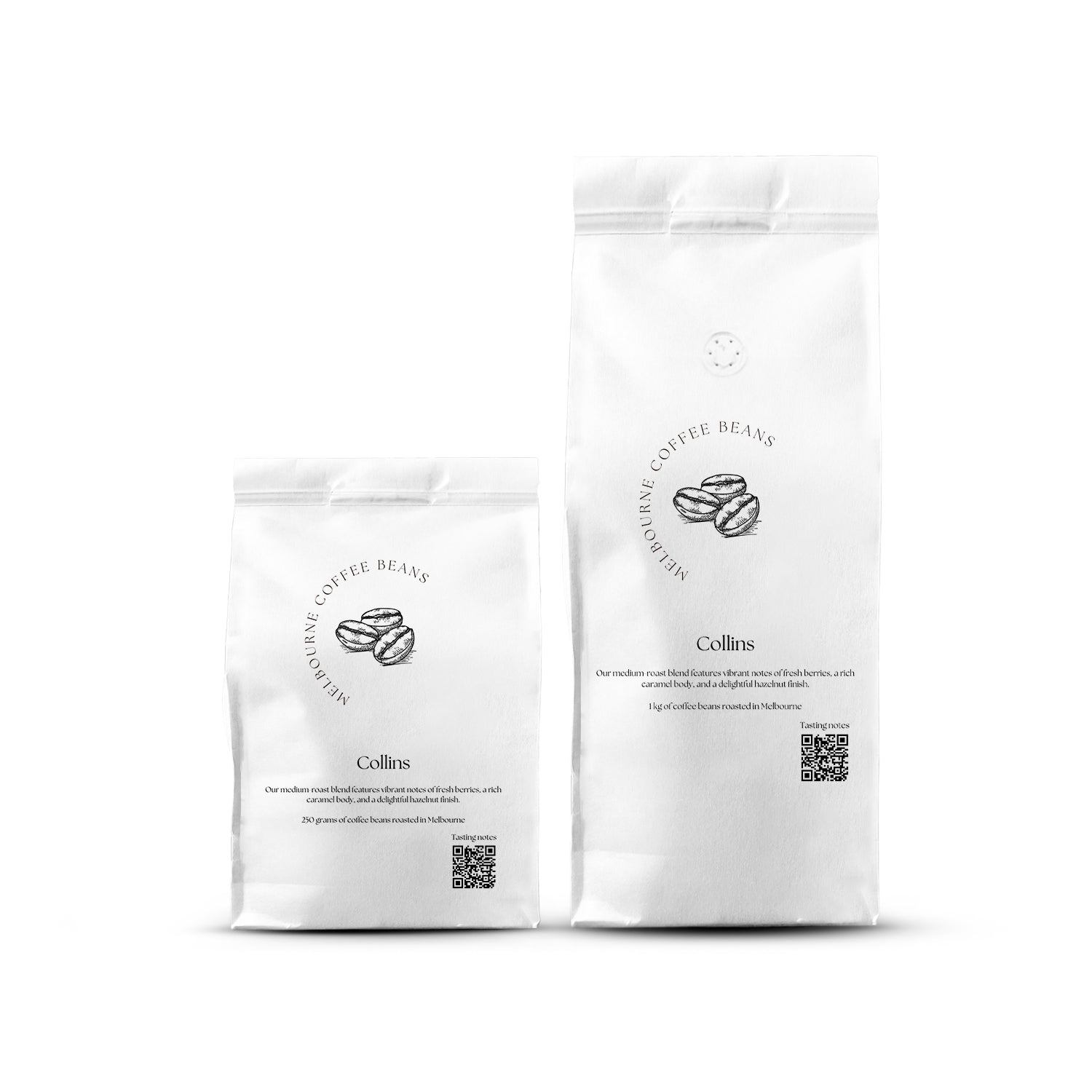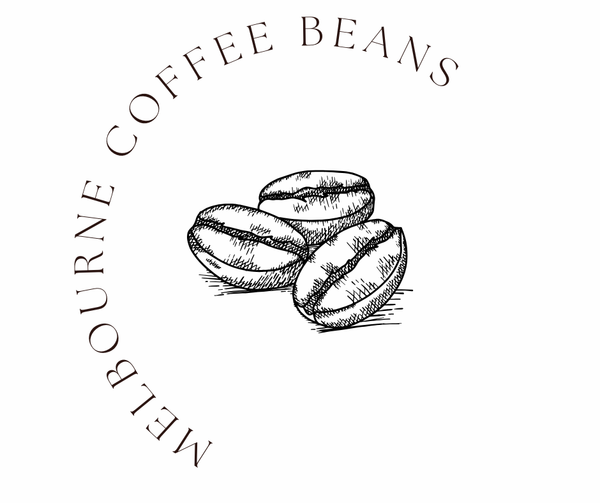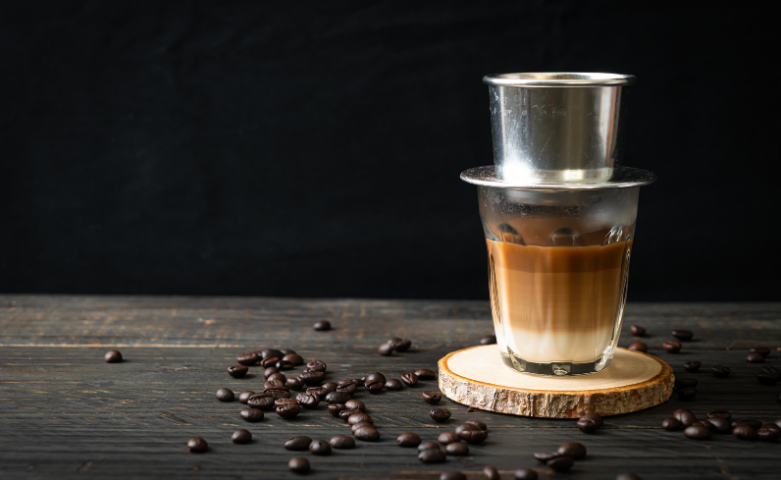Running a successful café is about more than just serving great coffee; it's about creating an unforgettable coffee experience that keeps customers coming back. In an industry where trends and tastes constantly evolve, staying ahead of the curve is crucial. One way to achieve this is by offering a wide range of brew methods that cater to various preferences and highlight the rich, complex flavours of your coffee beans.
In this blog post, we'll explore 7 innovative coffee brewing methods that every café owner should know. These methods will not only elevate your customer's coffee-drinking experience but also set your café apart from the others.
Whether you're looking to introduce something new to your menu or refine your current offerings, these brewing techniques will help you attract and retain customers ensuring your café remains a go-to destination for coffee lovers. Let's dive!
Key Takeaways
- Different brewing methods bring out unique flavours, helping your café cater to all kinds of coffee lovers.
- Precise brewing techniques ensure consistency, enhancing customer satisfaction and setting your café apart.
- Unique methods like siphon or Aeropress can create a memorable coffee experience, keeping customers coming back.
1. Pour-Over Brewing
Pour-over brewing is a method cherished for its simplicity and ability to highlight the nuanced flavours of specialty coffee beans. It involves manually pouring hot water over coffee grounds held in a filter, allowing for precise control over brewing variables like water temperature, pouring technique, and extraction time.
Pour-over brewing results in a clean, crisp cup of coffee with distinct flavour notes that vary depending on the coffee origin and roast profile. It highlights floral, fruity, and acidic notes, making it ideal for showcasing single-origin coffees and complex blends.
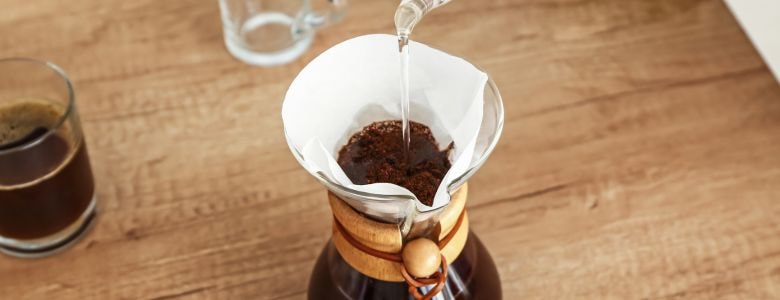
Equipment Needed: To execute pour-over brewing effectively, you'll need:
- A pour-over dripper (e.g., V60, Chemex, Kalita Wave brewing device)
- Freshly ground coffee beans (medium grind size)
- Filter papers
- Kettle with a gooseneck spout for precise pouring
- Scale and timer for accuracy
- A mug for serving
Coffee Water Ratio: 1:17 This means for every 1g of coffee beans you need to use 17g of water.
Steps to Brew the Perfect Pour-Over:
- Prepare the Equipment: Place the filter in the dripper and rinse it with hot water to remove any papery taste.
- Measure Coffee and Water: Use a scale to measure coffee grounds (typically 1:17 coffee-to-water ratio) and water (just off-boil, around 200°F or 93°C).
- Bloom the Coffee: Pour a small amount of water (twice the weight of the coffee grounds) over the coffee grounds and let it bloom for about 30 seconds. This allows gases to escape and prepares the grounds for full extraction.
- Pour in Stages: Start pouring water in a circular motion, gradually moving from the centre to the outer edge of the coffee bed. Maintain a steady flow to ensure even saturation.
- Control Extraction Time: Aim for a total brew time of around 3-4 minutes. Adjust grind size and pouring speed to control extraction and achieve desired flavour intensity.
Pour-over brewing not only enhances the coffee-drinking experience but can also allow you to showcase your coffee expertise and cater to your desired customers seeking quality and consistency in every cup.
2. Aeropress Brewing
Aeropress brewing has gained popularity for its versatility and ability to produce a rich, full-bodied cup of coffee in a relatively short time. Developed by Alan Adler, this method combines elements of immersion and pressure brewing to extract flavours efficiently.
The Aeropress consists of two main parts: a chamber and a plunger with a filter cap. It uses air pressure to push hot water through coffee grounds, resulting in a concentrated brew that can be enjoyed as is or diluted to taste.
Aeropress brewing offers several advantages, including quick brewing time (about 1-2 minutes), easy cleanup, and the ability to control extraction through variables like grind size and brewing time. It produces a clean, sediment-free cup with a smooth texture and rich flavour profile.
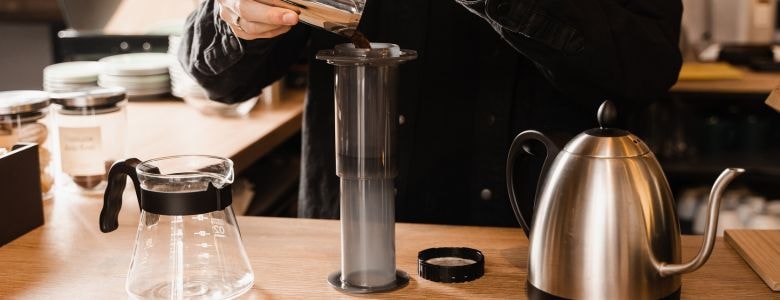
Equipment Needed: To brew coffee with an Aeropress, you'll need:
- Aeropress brewer
- Aeropress filters
- Freshly ground coffee (fine grind)
- Kettle with temperature control
- Stirring paddle, spoon or spatula
- Scale and timer for precision
Coffee Water Ratio: The coffee ratio for this brewing method is 1:16 this means that for every 1g of coffee, you'll need 16g of water.
Step-by-Step Brewing Guide:
- Heat the Water: Pour water into your kettle and heat it to (around 200-205°F or 93-96°C), which is the ideal temperature for Aeropress brewing.
- Prepare the Aeropress: Assemble the Aeropress by placing a filter in the filter cap and securing it to the chamber. Remember to wash the filter paper first using hot water to make sure the paper taste is removed and place it on a sturdy mug, carafe, or decanter.
- Measure and Grind Coffee: Measure coffee (around 15 grams, depending on desired strength) and grind it to a fine consistency.
- Add Coffee and Water: Add coffee grounds to the Aeropress chamber. Pour hot water over the grounds, ensuring all are saturated.
- Stir and Steep: Use a stirring paddle or spoon to agitate the coffee grounds for about 10-15 seconds. Attach the plunger and gently press down to create a seal.
- Start the Bloom: Add about 30ml of hot water to the coffee grounds, stir with the Aeropress paddle or a spoon, and let it bloom for 30 seconds. This step allows the coffee to degas and prepares it for full extraction.
- Add More Water: After your coffee has bloomed, pour your remaining hot water into the Aeropress, filling it up. Let it steep for one more minute.
- Stir and Cap: Once the time is up, gently stir the coffee and secure the Aeropress with the plastic cap.
- Press the Coffee: Gently invert the Aeropress over your mug or carafe and apply a steady downward pressure for approximately 30 seconds. When you hear a faint hissing noise, cease pressing immediately. This prevents the extraction of unwanted bitter flavours from the coffee grounds.
Aeropress Brewing is not only a practical addition to your café's repertoire but also a conversation starter for customers intrigued by its innovative approach to coffee preparation.
3. Siphon Brewing
Siphon brewing, also known as vacuum brewing, is a captivating method that combines science and artistry to produce a clean and flavourful cup of coffee. This method uses vapour pressure and vacuum suction to brew coffee, resulting in a brew that showcases the coffee's unique characteristics.
Siphon brewing involves two chambers connected by a tube—a lower chamber where water is heated and an upper chamber where coffee grounds are steeped and brewed. As water vapour rises, it mixes with coffee grounds before descending back into the lower chamber due to cooling.
This brewing method produces a clean and bright cup of coffee with a nuanced flavour profile. It highlights the coffee's acidity, sweetness, and aromatic notes, making it ideal for showcasing specialty single-origin coffees.
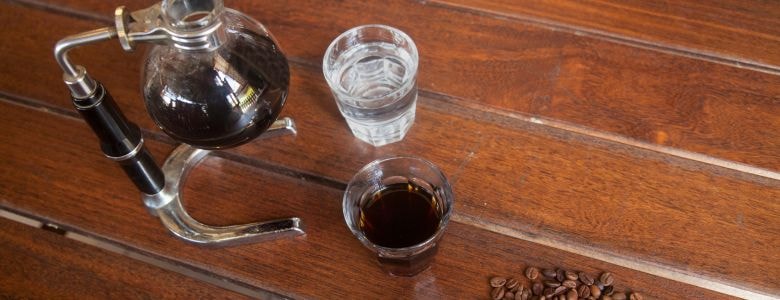
Equipment Needed: To brew coffee with a siphon brewer, you'll need:
- Siphon brewer (glass or metal)
- Siphon filter (cloth or metal)
- Freshly ground coffee beans (medium grind)
- Heat source (alcohol burner or butane burner)
- Scale and timer for precision
- Stirring utensil
Coffee Water Ratio: The coffee water ratio for this method is 1:15, meaning that for every 1g of coffee, you’ll need 15g of water.
Steps for Siphon Brewing:
- Prepare the Brewer: Assemble the siphon brewer and fill the lower chamber with water. Attach the upper chamber securely.
- Heat the Water: Place the brewer over a heat source and bring the water to a boil. Adjust heat to maintain a consistent temperature.
- Add Coffee Grounds: Insert the siphon filter into the upper chamber and add coffee grounds (typically 1:15 coffee-to-water ratio).
- Brewing Process: As the water in the lower chamber heats up, vapour pressure forces hot water into the upper chamber where it mixes with coffee grounds. Stir gently to ensure even saturation.
- Steep and Filter: Allow the coffee grounds to steep for about 1-2 minutes. Remove the heat source to create a vacuum effect, drawing the brewed coffee back into the lower chamber through the filter.
- Serve and Enjoy: Once all the brewed coffee has descended into the lower chamber, carefully remove the upper chamber. Serve the coffee immediately to capture its full flavour profile.
Siphon brewing not only delivers exceptional coffee quality but also adds a touch of elegance and sophistication to the café's coffee offerings, appealing to customers seeking a unique and memorable coffee experience.
4. Cold Brew
Cold brew is a popular brewing method known for its smooth, rich flavour and low acidity. This method involves steeping coarsely ground coffee in cold water for an extended period, typically 12-24 hours, resulting in a refreshing and versatile coffee concentrate.
The extended steeping time allows for a slow extraction process, which produces a coffee concentrate that can be diluted to taste with water, milk, or used as a base for various coffee drinks.
Cold brew's smooth, refreshing taste and versatility make it a favourite among customers, especially during warmer months. Its low acidity is gentle on the stomach, appealing to those who might find traditional hot coffee too harsh.
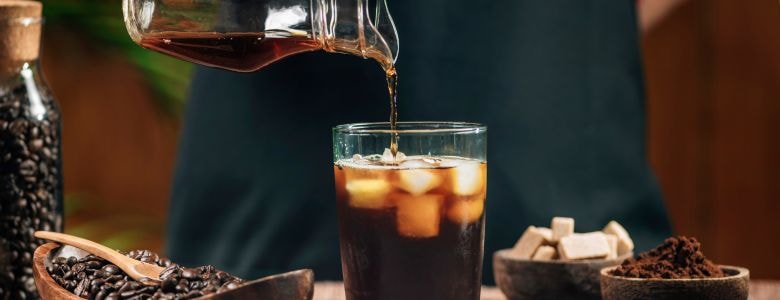
Equipment and Ingredients Needed: To make cold brew, you'll need:
- A large container or cold brew maker
- Coarsely ground coffee beans (medium coarse)
- Cold or room-temperature water
- Fine mesh sieve or coffee filter
- Scale for measuring coffee and water
- Storage container for the concentrate
Coffee Water Ratio: For a smooth, milder cold brew coffee, you can use a coffee-to-water ratio of 1:8. Furthermore, if you want a stronger, more robust coffee, then try using a ratio of 1:4.
Steps to Make Cold Brew Concentrate:
- Measure and Grind Coffee: Measure coffee beans (typically a 1:8 for a milder flavour and a 1:4 coffee-to-water ratio if you want to make them a bit strong) and grind them in medium-coarse grind size.
- Combine Coffee and Water: In a large container, combine the coarsely ground coffee with cold or room-temperature water. Stir gently to ensure all grounds are saturated.
- Steep: Cover the container and let it steep at room temperature or in the refrigerator for 12-24 hours, depending on your desired strength.
- Filter: After steeping, strain the coffee through a fine mesh sieve or coffee filter to remove the grounds, resulting in a smooth concentrate.
- Store and Serve: Transfer the cold brew concentrate to a storage container and refrigerate. Dilute with water, milk, or other liquids to taste before serving.
For a more detailed guide, you can check out our latest blog on how to make cold brew coffee.
In brewing coffee, the cold brew method is an excellent addition to any café menu, offering a unique and refreshing coffee option that can be easily prepared in advance, ensuring quick and efficient service for your customers.
5. Turkish Coffee
Turkish coffee is a traditional and time-honoured brewing method known for its strong, rich flavour and unique preparation process. This method involves brewing finely ground coffee with water and sugar (optional) in a special pot called a cezve, resulting in a thick, unfiltered coffee with a distinctive taste.
Turkish coffee is deeply rooted in Middle Eastern culture and is often enjoyed as part of a ritual or social gathering. Serving Turkish coffee in a café provides customers with a unique cultural experience and an opportunity to enjoy a traditional brewing method.

Equipment Needed: To brew Turkish coffee, you'll need:
- Cezve (a small, long-handled pot)
- Finely ground coffee beans
- Water
- Sugar (optional)
- Small coffee cups (often demitasse)
Coffee Water Ratio: The coffee water ratio for this method is 1:12, meaning that for every 1g of coffee, you’ll need 12g of water.
Traditional Brewing Process:
- Measure Ingredients: Use a small coffee cup to measure cold water, one cup per serving. Add water to the cezve.
- Add Coffee and Sugar: Add one teaspoon of finely ground coffee per cup of water. Add sugar to taste, if desired (common options are no sugar, a little sugar, or a lot of sugar).
- Mix and Heat: Stir the mixture gently to combine the coffee and sugar with the water. Place the cezve on low heat.
- Watch for Froth: As the coffee heats, a froth (foam) will form on the surface. Just before the coffee starts to boil, remove the cezve from the heat to prevent overflowing.
- Pour and Serve: Carefully pour the coffee into small cups, distributing the froth evenly. Allow the coffee grounds to settle at the bottom before drinking.
Turkish coffee adds a touch of tradition and elegance to your café's menu, offering customers a rich and authentic coffee experience that stands out from modern brewing methods.
6. Moka Pot Brewing
Moka pot brewing is a classic and beloved method that produces a strong, espresso style coffee. Invented in Italy in the 1930s, the Moka pot uses steam pressure to force hot water through coffee grounds, resulting in a rich, flavorful brew.
The Moka pot consists of three parts: a bottom chamber for water, a middle funnel for coffee grounds, and an upper chamber for brewed coffee. As the water heats, steam pressure pushes it through the coffee grounds, creating a robust coffee similar to the ones made by an espresso machine.
Moka pot coffee is strong and full-bodied, similar to espresso, but with a slightly different flavour profile. It's perfect for making lattes and cappuccinos or enjoying on its own.
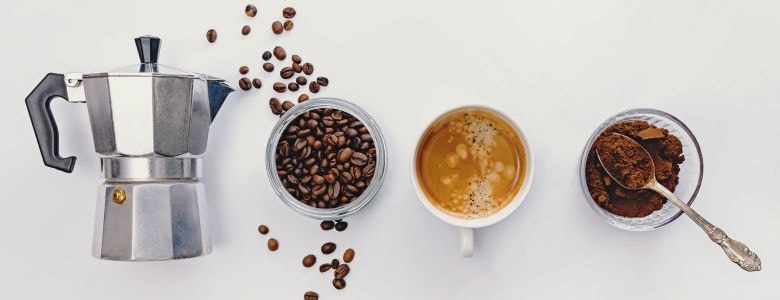
Equipment Needed: To brew coffee with a Moka pot, you'll need:
- Moka pot (also known as a stovetop espresso maker)
- Freshly ground coffee (fine grind)
- Water
- Heat source (stovetop)
Coffee Water Ratio: The coffee water ratio for this method is 1:10-1:13. For example, for every 1g of coffee, you’ll need 13g of water.
Steps to Brew with a Moka Pot:
- Prepare the Moka Pot: Fill the bottom chamber with water up to the safety valve. Insert the funnel and fill it with coffee grounds, levelling them off without tamping.
- Assemble and Heat: Screw the top chamber onto the bottom securely. Place the Moka pot on a stovetop over medium heat.
- Brewing Process: As the water heats, it creates steam pressure that forces the water up through the coffee grounds and into the top chamber. Listen for a bubbling sound, as this indicates that the brewing is nearly complete.
- Serve Immediately: Once the top chamber is filled with brewed coffee and the sound subsides, remove the Moka pot from the heat. Serve the coffee immediately.
Moka pot brewing adds a touch of tradition and authenticity to your café's offerings, providing customers with a robust and satisfying coffee experience reminiscent of classic Italian espresso.
7. French Press Brewing
French press brewing, also known as press pot or plunger pot, is a popular and straightforward method that produces a rich, full-bodied coffee. This immersion brewing technique allows coffee grounds to steep in hot water, resulting in a flavourful cup.
The French press consists of a cylindrical glass or stainless steel container with a plunger and metal mesh filter. Coffee grounds and hot water are combined and steeped together before the plunger is pressed down to separate the grounds from the coffee brewed.
French press brewing method produces a coffee with a rich, full-bodied flavour and a slightly oily texture due to the lack of paper filters, which allows more of the coffee's natural oils to remain in the brew.
French press coffee is versatile and can be enjoyed black or with milk and sugar. It's also an excellent base for various coffee drinks, such as lattes, cappuccinos, and iced coffee.

Equipment Needed: To brew coffee with a French press, you'll need:
- French press
- Freshly ground coffee (coarse grind)
- Hot water (just off the boil, around 200°F or 93°C)
- Stirring utensil
- Timer
Coffee Water Ratio: For a smooth, milder flavor, you can use a coffee-to-water ratio of 1:15. Furthermore, if you want a stronger, more robust coffee, then try using a ratio of 1:12. For example, for every 1g of coffee beans there should be 12 grams of water.
Steps to Brew with a French Press:
- Preheat the French Press: Preheat the French press with hot water to maintain the brewing temperature. Discard the water before adding coffee grounds.
- Measure Coffee and Water: Use a scale to measure coffee grounds and water. Add the coarsely ground coffee to the French press.
- Add Hot Water: Pour hot water over the coffee grounds, ensuring all grounds are saturated. Stir gently to combine.
- Steep: Place the lid on the French press with the plunger pulled up. Let the coffee steep for about 4 minutes.
- Press and Serve: After steeping, slowly press the plunger down to separate the grounds from the brewed coffee. Pour the coffee immediately into cups to avoid over-extraction.
French press brewing is a versatile and straightforward method that adds depth and richness to your café's coffee offerings, appealing to customers who enjoy a robust and flavorful cup.
Conclusion
Mastering these seven coffee brewing methods can significantly elevate your café's offerings and enhance your customers' experience. From the precision of pour-over and the convenience of Aeropress to the theatrical appeal of siphon brewing and the cultural richness of Turkish coffee, each method brings its unique characteristics to the table.
By incorporating these diverse brewing techniques, you're not just serving coffee; you're providing a journey through the world of coffee craftsmanship. This variety allows you to cater to different taste preferences, showcase the nuances of your coffee beans, and keep your menu fresh and exciting.
Remember, the key to success lies not just in the methods themselves but in the quality of your beans, the skill of your baristas, and your passion for the craft. Encourage your staff to master these techniques and educate your customers about the unique attributes of each brewing method.
As you implement these brewing methods in your café, you'll be well-positioned to attract coffee enthusiasts, differentiate yourself from competitors, and create a reputation as a destination for exceptional coffee experiences.
Frequently Asked Questions:
Which coffee brewing method is the best?
The best coffee brewing method depends on your personal preference and desired flavours. Some prefer the clarity and control of pour-over, while others enjoy the rich, full-bodied profile of French press or the smoothness of cold brew.
How many brewing methods are there?
There are numerous coffee brewing methods, each offering unique ways to extract flavors from coffee beans. Common methods include pour-over, Aeropress, French press, siphon, Moka pot, Turkish coffee, and cold brew, among others.
What is the preferred brewing method?
The preferred brewing method varies widely among coffee enthusiasts and depends on factors like flavour preference, convenience, and desired strength. Popular choices often include pour-over for its clarity or espresso for its intensity and versatility in specialty coffee drinks.
Which method makes the strongest coffee?
Methods like cold brew and Moka pot are known for producing strong, concentrated coffee due to their high-pressure extraction processes. These methods typically yield a strong flavour profile that's ideal as a base for lattes and other espresso-based drinks.
Which brewing method takes the longest?
Siphon brewing is typically the slowest method due to its intricate setup and process. It involves heating water in a lower chamber, which then rises to brew coffee in an upper chamber before filtering back down. This meticulous process results in a clean and flavorful cup but requires patience.
